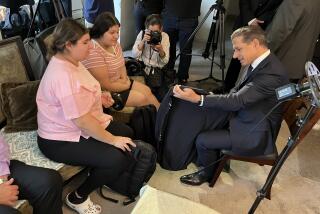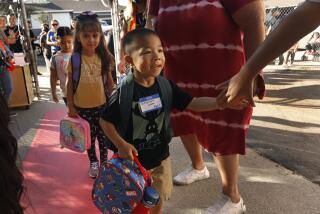Swine flu won’t mean school’s out
- Share via
Educators should be conservative when they consider shutting schools because of outbreaks of swine flu, or the H1N1 virus, federal officials said Friday as they released guidelines for school districts.
While emphasizing that such matters are local decisions, the officials said a desire to prevent the virus’ spread must be balanced with the fallout from school closures -- parents struggling to find child care, children left unsupervised, and disruption to education.
“Once you close a school, as we saw last spring, that causes a very significant ripple effect because children need to stay home,” Homeland Security Secretary Janet Napolitano said at a morning news conference with education and health officials in Washington.
H1N1 was first detected in this country in April. More than 700 schools throughout the nation, including 37 in California, closed because of suspected outbreaks. Overnight camps were particularly hard-hit with flu cases this summer, prompting some to send children home.
Dr. Thomas R. Frieden, director of the Centers for Disease Control and Prevention, said health officials and scientists have learned more about the virus since the spring. Young people are particularly susceptible, but in healthy people, the symptoms tend to be mild. Parents had been urged to keep sick children home for seven days after a fever ended; now, officials say children only need to be kept home 24 hours.
“It’s now more clear to us, perhaps, than it was before: There are relatively few reasons and rare times when it makes sense to close a school just because the virus was present,” Frieden said.
Exceptions are schools that serve vulnerable populations, such as pregnant teens or students in fragile health with conditions such as muscular dystrophy, he said. Another reason to close would be if classes could not continue because many students and staff were absent.
Local school districts must develop plans for handling sick children at school, including setting aside an isolation room where they can rest while waiting to go home, and creating a system to allow education to continue.
“Realistically, some schools will close this fall. It’s incredibly important to all of us that our students continue to learn,” U.S. Education Secretary Arne Duncan said. “Educators need to start thinking now about having temporary home school in place using both phones and the Internet.”
Parents are urged to get their children the two-dose vaccination when it becomes available in October. School officials also are encouraged to be vigilant in teaching children preventive behavior, such as washing hands frequently and coughing into a sleeve.
If the strain mutates into something more serious, officials said stricter precautions will be needed, such as screening children for fever when they come to school every morning, not allowing large student gatherings, and dismissing students at different times.
In Los Angeles County last spring, educators and health officials were more conservative than their counterparts in other parts of the state. No school in the county closed despite a handful of suspected outbreaks.
Dr. Kimberly Uyeda, director of student medical services for the Los Angeles Unified School District, said the district has completed many of the recommendations. Letters detailing illness prevention were sent to families over the summer and will be included in opening-day packets, she said.
The district is considering various methods of continuing children’s education, including public-access television, automated phone calls, the Internet and the mail to deliver instructions and lessons, she added.
Federal guidelines for colleges and preschools are forthcoming.
--
More to Read
Sign up for Essential California
The most important California stories and recommendations in your inbox every morning.
You may occasionally receive promotional content from the Los Angeles Times.














